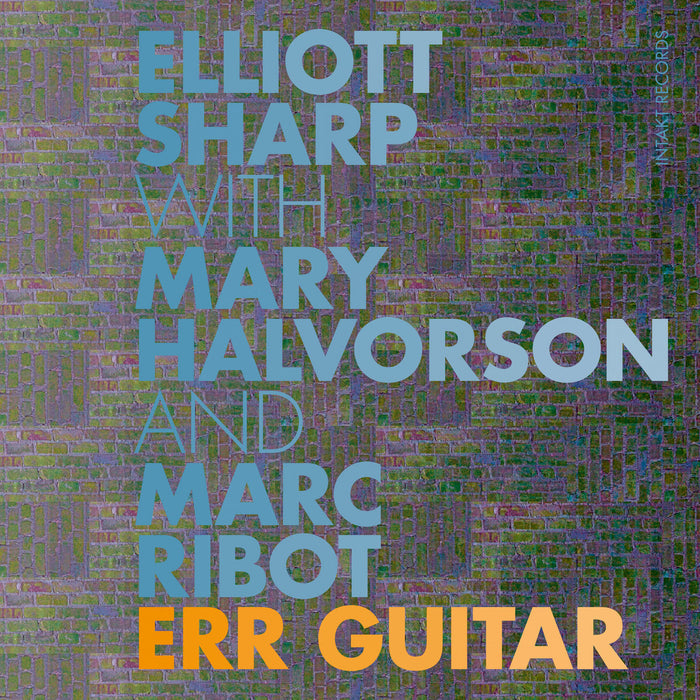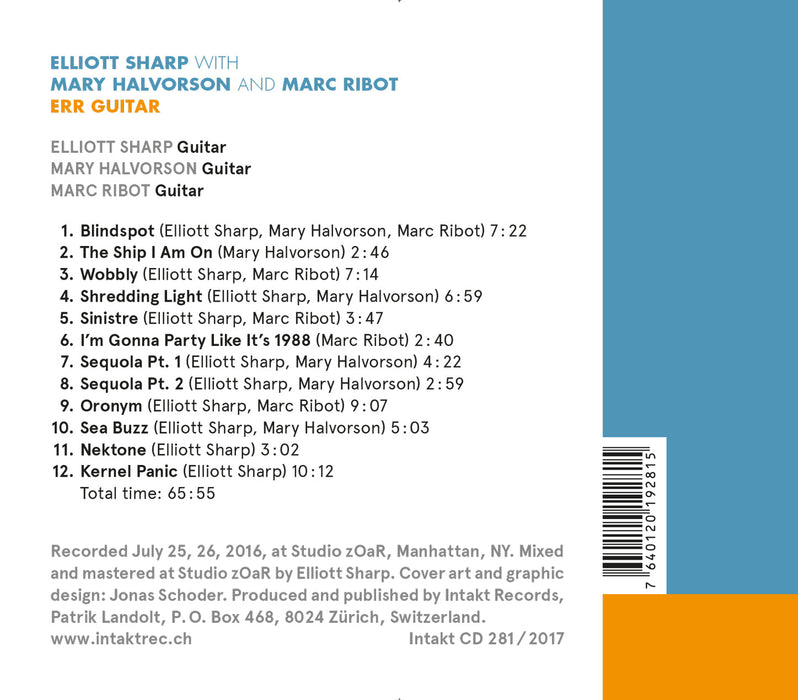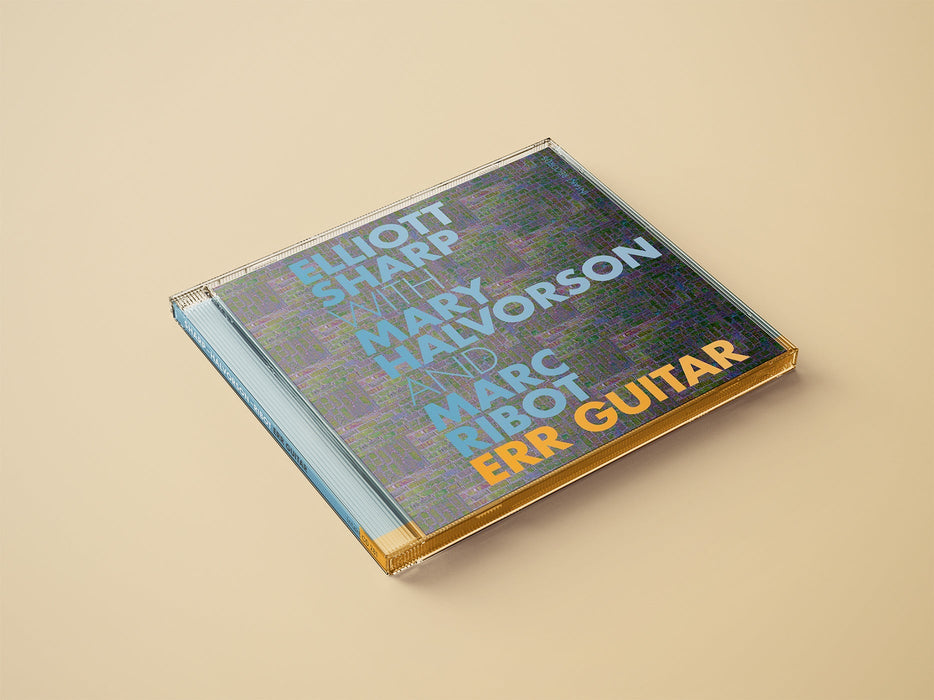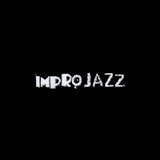


281: ELLIOTT SHARP with MARY HALVORSON and MARC RIBOT. Err Guitar
Intakt Recording #281/ 2017
Elliott Sharp: Guitar
Mary Halvorson: Guitar
Marc Ribot: Guitar
Recorded July 25, 26, 2016 at Studio zOaR, Manhatten, NY.
More Info
Last summer in Elliott Sharp’s recording studio in Manhattan, New York guitarist Sharp spent a day with guitar colleague Mary Halvorson and another with Marc Ribot, legendary guitarist of Tom Waits, The Lounge Lizards and Marianne Faithful. The result was a series of recordings that could only be created by friends. They represent the great art of guitar playing by three exceptional musicians looking for new sonic adventures in search of the sound of our time. “I hear in their playing both a step into an unknown future and wild growth from a deep past,” says Elliott Sharp. “The contradiction is resolved in improvisation – the transcendent sonic path of the now.”
Album Credits
Cover art and graphic design: Jonas Schoder
Recorded July 25, 26, 2016 at Studio zOaR, Manhatten, NY. Mixed and mastered at Studio zOaR by Elliott Sharp.Produced and published by Intakt Records, Patrik Landolt, Zürich, Switzerland.
Avec ses confrères Eliott Sharp et Marc Ribot, Mary Halvorson mêle son jeu à celui de deux personnalités singulières avec lesquelles elle partage le travail de composition. Elle est parfaitement à son aise dans cet environnement masculin où la six cordes électrique est traitée de façon orchestrale et dans tous ses états. La guitariste s’affirme ainsi comme une des meilleures représentantes de cette approche ouverte d’un instrument dont l’histoire dans le jazz — parallèlement à la tradition qui se perpétue — continue à s’écrire de la façon la plus aventureuse. Soit un panel d’instrumentistes qui dépasse largement le rôle de chanteuse ou de pianiste ordinairement réservé aux femmes dans le monde du jazz.
Il n’est pas étonnant qu’un label indépendant suisse leur accorde une place aussi importante. C’est en effet des marges qu’on peut attendre une telle ouverture, et les grands labels restent à ce niveau très timides et traditionnalistes.
Bravo donc à Intakt et à ses producteurs — dont l’une est une femme, Anja Illmaier, ce qui est loin d’être courant dans la jazzosphère internationale.
https://blogdegarenne.blogspot.com/2020/10/gender-stories-2.html
Guitar summits can be awfully dull affairs. But with G the right players - understanding the possibilities of effects and percussive techniques as well as chords, color, and line - they can be dazzling. Like this one. But even before you listen, you know from a glance at the players here that we're a long way from McLaughlin, DiMeola, and DeLucia, sisters and brothers. That's not just because of the quirky recording method, which featured one duo per day, with conscious effort to leave room for the third player to record their contribution subsequently. It has more to do with the way each player here exults in idiomatic properties of the guitar, without being constrained by the instrument's expectations.
The opening trio sets the table, with a full strings ecosystem of wild little buzzes and scuffles. Halvorson is unmistakable at this point, with her cosmic effects and earthy lines contrasting masterfully. And indeed, taking Sharp's flinty playing and Ribot's quirky twang into the equation, counterpoint takes on new meanings here. Instead of mere notes and chords, these pieces are overstuffed with anything sonic that the guitar can produce but with a musical logic that makes intuitive sense and grabs you if your ears are open enough. Chiming, resonant repetitions dot the multi-tracked Halvorson piece "Ship," all loops stacked up and toppling over. There's a fine feature for Ribot and Sharp on acoustic, "Wobbly," with loads of rough woody slashing contrasted with sudden introspection and dynamic shifts. But generally things tend towards the more cosmic ("Shredding Light") or the noisy ("Sinistre" or "I'm Gonna Party Like It's 1998"). Sharp makes nifty use of his Ebow on the resonant "Sequola," where Halvorson plays with an unmediated, emphatic lyricism on her acoustic. And there's a monster drone on "Oronym," which also crawls with little electronic insects
struggling to stay alive under the sonic weight. The final trio returns to the vibe of the opener, darting and slashing everywhere. Lots of settings like this can sound clinical and overly technique-obsessed. These three use the guitar as a springboard to pure, shared invention.
Dans cet antre du brumeux où chacun aurait pu se dissimuler, les voici, au contraire, se dévoilant. Bien sûr, Elliott Sharp mine l'arpège, Marc Ribot broie le texte et Mary Halvorson détériore l'harmonie: en cela, on ne les changera pas.
Si Mary Halvorson se démultiplie en solo, si le Sharp soliste amalgame les angoisses et si Ribot croise à merveille le rouillé de ses cordes, ce sont les duos qui, ici, attirent l'oreille.
Sharp-Ribot d'abord en acoustique pointilleuse tailladant l'harmonique d'un proto-folk malade puis invitant saturation et anamnèse à se réconcilier. Le duo Sharp- Halvorson est une ruche électrique où s'accomplissent des duels soniques sans vainqueurs; ruche- astre aux sonorités lunaires bien vite oubliée quand leurs acoustiques guitares s'envolent en des vélocités encombrantes. Evidemment, si vous n'aimez pas les guitares..
Le grand guitariste américain Elliott Sharp (cf. Culturejazz « C’était en 2013 : 2e séance de rattrapage » 14/01/2014) a réuni deux autres guitaristes américains non moins grands, Mary Halvorson et Marc Ribot, pour une série de duos (plus quelques trios et solos). Depuis les débuts de la guitare dans le jazz (Lonnie Johnson & Eddie Lang), les duos ont toujours été pratiqués et appréciés. Parfois, les registres voisins de l’instrument peuvent s’embrouiller ou bien c’est la musique qui tourne dans le vide, des écueils souvent difficiles à éviter. Ici, les discours s’entrelacent, s’entremêlent, mais gardent leur lisibilité malgré leur complexité (pas de soliste ni de rythmique). Pas non plus d’effets sonores faciles et superflus, les jeux et phrasés sont résonnants mais évitent toute saturation, même lors de moments intenses. Et surtout, pas de clichés ! Alors, amateurs de belle guitare et de chemins aventureux, ce disque est pour vous.
https://www.culturejazz.fr/spip.php?article3360
Na prossecução do seu desejo de construir uma utopia da guitarra, ou seja, uma música guitarrística que tenha as suas lógicas nela própria e em mais nada, e que ao longo do tempo foi ganhando expressão em projectos a solo, à frente de vários grupos ou até encomendando peças a outros músicos para a criação de compilações (caso da série “I Never Meta Guitar” na Clean Feed), Elliott Sharp convidou outros dois guitarristas inventivos da actualidade, Mary Halvorson e Marc Ribot, para verificar o que acontecia – o resultado é este “Err Guitar”, com a fonia a sugerir a designação Air Guitar para as mimetizações gestuais com que se “toca” um instrumento que é apenas imaginário. O seu propósito era que «se desse um passo num futuro desconhecido, mas nascido do passado mais profundo», resolvendo todas as contradições inerentes por via da improvisação, esse «caminho sónico transcendente do agora». O que não quer dizer que os solos, duos e trios constantes neste disco tenham sido integralmente improvisados no seu estúdio de Nova Iorque: Sharp transmitiu as premissas do projecto aos seus parceiros de ocasião e cada peça deriva de um conceito, uma estrutura ou uma composição (a uma, duas ou três mãos). O homem que já interpretou / transfigurou a escrita para piano de Thelonious Monk numa seis-cordas não acredita que possa existir uma improvisação totalmente livre e por isso não só não a pratica (salvo algumas excepções) como desconfia de quem o faz. O que aqui se ouve é improvisação emoldurada, na justa medida que permite a cada um dos intervenientes deixar a sua própria marca individual.
O passado é convocado pela adopção de técnicas que vêm dos confins históricos da folk, dos blues, do rock e do jazz, como por exemplo o “fingerpicking” e o uso de “bottlenecks”, e o futuro a que se pretende chegar surge nos processos inovadores, nos parâmetros estéticos (e daí que alguns críticos já tenham comentado que esta é uma música «de outro planeta») e nos usos deveras criativos dos pedais de efeitos, do “looping” e do “sampling”, regra geral parecendo que não são guitarras que estamos a ouvir. Mas se a guitarra que está para além da guitarra, a guitarra utópica, atravessa todos os 12 temas, em todos os momentos também é confrontada por elementos da guitarra tradicional, como se se tivesse ampliado a um nível macro os contrapontos desenvolvidos. Às tantas, deixamos de perceber onde termina um tipo de abordagem e começa o outro, tão simultaneamente presentes e tão em osmose ambos vão ocorrendo, o que passa, inclusive, pelo esbatimento das distinções entre eléctrico (electrónico) e acústico. Eis, pois, um álbum que, para além de agradar ao ouvido, nos põe a pensar.
https://www.jazz.pt/ponto-escuta/2018/01/25/elliott-sharp-mary-halvorson-marc-ribot-err-guitar-intakt/
Deze ludieke opname in trio behelst in werkelijkheid een reeks duo's tussen gastheer Elliott Sharp en zijn 2 gasten. 2 trio's zijn ontstaan door studio-indub- geen bezwaar bevat. Trippelende, hakkelende en zwevend verbogen gitaarklanken vloeien en brokkelen in en uit mekaar. Effectieve melodiëen worden niet nagestreefd en zijn geen uitgangspunt van deze wonderlijke, onaardse gitaarwereld. Effectpedalen en alternatief gebruik van de snaren en electronica leggen een vreemd, doch nooit schreeuwerig of agressief kleurenpalet bloot. Men kan hier de woorden noise en sounds- capes makkelijk gebruiken, doch gaat het in wezen veel meer om spontane gesprekken waarbij de alchemisten in elkaar kruipen.
Composer, bandleader, multi-instrumentalist, Elliott Sharp is a musician hard to classify, with equal proficiency in blues-rock, improvisation and new music. Here he concentrates on his main instrument, the guitar, on a dozen solos, duos and a trio with fellow pickers Mary Halvorson and Marc Ribot. Oddly enough, Sharp and Ribot, who specialize in more agitated sounds, both turn almost folksy in duets on Wobbly, Sinistre and Oronym. Although their chess game-like moves are both subtle and spiky on Sinistre, it’s the last track which is most distinctive. Here, one guitarist’s legato finger-picking tries to surmount the other’s canine yapping-like plucked onslaughts, until relaxed string undulations are replaced by a multiplicity of crying buzzes. Blanketing drones dominate the three Halvorson duets, with the strokes on Shredding Light so thin they break into electronic flanges. Slurred fingering and guitar-neck taps enliven both parts of Sequola, although a blanket of buzzes can’t disguise intricate dual connections.
Sharp’s solo work, however, is the most representative. Nektone for instance swiftly unites Delta bottleneck picking and outer-space-like multiphonics without fissure. Meanwhile, Kernel Panic knits together so many passing chords that it’s almost opaque. Then suddenly, with no hint of overdubbing, there seem to be two guitar lines travelling in opposite directions – one with rumbling organ-like ostinato, the other snapping out arena-sized distortion. That he manages to tame these opposites into a reassuring ending that is true to narrative, logical and conclusive, is another tribute to Sharp’s multi-talents.
https://www.thewholenote.com/index.php/booksrecords2/jazzaimprovised/27339-err-guitar-elliott-sharp-with-mary-halvorson-and-marc-ribot
No note is a mistake if the next one redeems it, right? This gets especially challenging in a setting where you don't know what the other players are playing; the best you can do is guess what the next good note should be. This two- day session hosted by Elliott Sharp, who invited fellow string-slingers Mary Halvorson and Marc Ribot to his studio, was originally envisioned as a series of duets culminating in a trio. It became a next-level music-plus-one situation when scheduling mandated that Sharp and Ribot play without Halvorson, forcing them to imagine what he she might play and requiring her to respond without seeing the players she was playing "with." Never mind jamming, such a setting is more of a test of a player's ability to think their way out of a jam-ergo, Err Guitar.
The outcome is a series of tense tangles, some fully acoustic, some subject to the influence of circuitous circuit chains. Each player gets one baseline-establishing solo. Halvorson's delay-enabled passage points out that even solos can be conversations between what the soloist thought and what the soloist is thinking. Ribot signals that he finds the situation a bit comic by opening his solo selection, "I'm Gonna Party Like It's 1988," with a snippet of "Three Blind Mice." Sharp flies between processed and pure tonal options like a caffeinated gibbon swinging through the rainforest canopy; it's undeniably skilled and quite spectacular, but a bit exhausting to follow. The most densely knotted duets compound this experience, but there are also moments where the players ease back and let the music breathe.
Credit is due to Sharp for his engineering, which captures the session in radiant, three-di- mensional detail.
Äh, Gitarre
Stian Westerhus, Ronny Graupe, Jacob Bro, David Torn, Kalle Kalima, Nels Cline, Christian Fennesz, um nur mal ein paar Namen zu nennen. Will sagen: Der Gitarre in der improvisierten Musik geht's so gut wie lange nicht. Auf welchem Abstraktionsniveau, jenseits von Konvention, Song und Groove, mittlerweile agiert wird, zeigt sehr eindrucksvoll und durchaus nicht ohne Humor das Duo-Trio-Album >>Err Guitar<«, das an zwei Tagen im Juli 2016 in Elliott Sharps Zoar-Studio in New York entstanden ist.
Sharp, Jahrgang 1951, ist seit Jahrzehnten eine äußerst produktive Größe der New Yorker Avantgarde. Marc Ribot, Jahrgang 1954, spielte einst bei den Lounge Lizards und in diversen Bands von John Zorn, veredelte die Platten von Tom Waits mit allerlei komischen Sounds und schüttelte immer wieder irrwitzige Projekte aus dem Ärmel. Zuletzt etwa The Young Philadelphians, eine Band, der das erstaunliche Kunststück gelingt, sich gleichzeitig vor Ornette Colemans Prime Time und dem Phillysound der Siebziger zu verbeugen. Bei den Young Philadelphians ist auch Mary Halvorson, Jahrgang 1980, mit von der Partie, die seit ihren Arbeiten mit Anthony Braxton und Ches Smith als originellste Gitarristin ihrer Generation gilt.
Und jetzt also eine Art Gipfeltreffen: zwei Tage in New York. Kein Schwanzvergleich wie damals in der Freitagnacht von San Francisco, sondern eine Reihe von Gesprächen unterschiedlichen Temperaments. Die Sache mit der angedachten Triokonstellation ließ sich aus Termingründen nur virtuell herstellen, wurde dafür aber sehr aufregend gemeistert. Alles scheint möglich im Zwiegespräch, auch Dissens. Mitunter dauert es nur wenige Takte, bis sich aus Klängen, die an eine blubbernde Wasserquelle denken lassen, ein Reggae-Rhythmus schält (>>Shredding Light<<). Dann wieder lugen Blues, Ragtime oder Bluegrass verstohlen ums Eck >>(I'm Gonna Party Like It's 1988<). Geradezu unheimlich wird es bei >>Sea Buzz<«, wo zur Slide-Guitar Geisterstimmen, ja, echt jetzt, Kindergeisterstimmen zu hören sind.
Es hilft ungemein, wenn man zu verges- sen versucht, dass man gerade dabei zuhört, was drei Musiker den ihnen zur Verfügung stehenden 18 Saiten abzuringen wagen - und einfach die Ohren öffnet.
Gipfeltreffen der Gitarrenfreigeister: Elliott Sharp, Pionier der New Yorker Downtown-Szene, lud im letzten Sommer Mary Halvorson und Marc Ribot je einen Tag in ein Studio in Manhattan zu musikalischen Erkundungsreisen. Tausendsassa Ribot, omnipräsent von Tom Waits bis John Zorn, ist nicht nur Weggefährte von Avantgarde-Ikone Sharp, sondern hat auch die aufstrebende Gitarristin Halvorson schon zu mehreren gemeinsamen Projekten eingeladen. Seelenverwandtschaft ist also über die Generationen hinweg garantiert. Die Persönlichkeiten der drei Musikabenteurer sind, wenn etwa Ribots Spiel wie auf Spinnenbeinen daherkommt, unüberhörbar. „Err Guitar" ist keine leichte Kost, aber für geduldige Hörer ein spannendes Dokument dessen, was auf sechs Saiten alles möglich ist.










